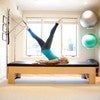Description
About This Video
Transcript
Read Full Transcript
Posture is more than standing up straight. Posture is a connection between your feet, your thighs, and your shoulders. And what I'd like to talk about now is the relationship between what I call your button, your thigh. Sometimes people have called it the [inaudible] connection. Sometimes they've called it the posterior, but thigh connection. Sometimes we call it the glute hamstring connection.
Regardless of what it's called, it's that relationship between your glutes and your hamstrings. Oftentimes what can happen is people will overuse their hamstrings, they'll get really tight legs behind their hamstrings, which is in the back of your thigh and minimize the action of their glutes. So the first thing we have to recognize is where are your thighs? For example, sometimes when people stand up tall and maybe they've been told to keep their bottom underneath them. I'm not even gonna use the word Tuck because some people use that.
I'm not judging the word. What I want you to realize is what the word or what the Q might do to your body. For example, if I choose to Tuck my bottom, I tuck my bottom and my belly comes in. But what happens is my thighs kind of bulge. Okay. And then some people kind of hang in that, okay, and this person here really has very limited access to their glutes because when you're in a tuck to bottom or a pelvis that's posteriorly tilted, you're already occupying your hips in hip extension.
So you're not going to get the maximum amount. The opposite side of that is when I softly bend my knees, which is often also a common cue, and then I stick my butt out and then when I go to stand up, I'm standing like this. So this is an anteriorly tilted pelvis and my butt is sticking out. So both of those extremes challenged certain areas of the body, but you just have to recognize where you are so that you can get the exercises that are ideal for you. So what happens is a lot of times people who tuck a lot, maybe a teacher or somebody will tell you, just don't Tuck your bottom.
So maybe your body will just go from here all the way to here. Or if you're here, a teacher will say, come on, Tuck your bottom. And then you'll go there. But the gift of the exercises in the journey, if you will, from one position to the other. So just the absence of tucking or the absence of arching doesn't mean the polar opposite. So we have to recognize where we are to re to see where we want to beat.
Kinda like your gps, you know when you have your little blue ball on there, you got to know where you are before you know where you can go from that point. So in this tutorial here, I'm going to do just a couple of exercises for both types. So the first exercise, and you have a home belt here, this is gonna help us do an exercise on our thigh and then a, a blanket or a pillow or something that will help you in this position, or you have a blanket that can help you when we need to get in various positions. So we'll start with the blanket on the mat and I'm going to go ahead and lie right on my back and I'm going to put the blanket directly under my pelvis. So in this position, I'm actually going to lengthen out this leg and pull my other knee into my chest. So just in this position, this blanket has lifted my pelvis a little bit that as I reach long through my left leg, I'm getting a little lengthening in the front of this thigh so I can bend and stretch this leg to create this lengthening here that actually helps me engage the glute in the back. Take my other leg in, stretch out my right leg.
So it's really me pulling in this opposite leg that lets me lengthen the other leg out. And then I bring two knees in if I can. I'm going to put my hands on my pelvis and then lengthen both legs out and by meaning if I can, I know that I can do this, but I just want to see if I can lengthen my legs. Look without going into my choice of an arched back. If I'm in this arched back and the teacher says, or you think, oh, I have to Tuck my bottom. This isn't going to do anything to change this.
So I need to get out of the exercise, regroup, re lengthen, re heavy my back ribs, and then lengthen one leg length in the other leg because I have to get the support in the front of my body to lengthen the front of my body, to access the back of my body and which are my glutes. I'm going to breathe in here and breathe out here. And sometimes just lengthening this way is enough. After I get that feeling of lengthening, I'm in a turnover and now I'm going to put the blanket or the pillow underneath my pelvis. So when I lie down this way, now my hip crease right here is right at the edge of this blanket so that if I did have tight hips, my hips would kind of be resting in a flexed position, if you will, as I lie down. So when this position right here, I'm willing to put my head down the lengthen out the front of my thighs and then now I'm going to bend my right knee and flatten out my foot. I'm propped up. Just so I can explain this to you.
Um, as I lift up my leg, I want to be sure that I don't flex my knee more. Okay. Because that will put more stress on the front of the hip. So I really want to just bend my knee to about 90 degrees and flatten out my foot. And then from this position, I'm going to lift this leg up to engage my glute. And you should feel your glute right away. You can just put your hand right here and then lower down.
I'm now going to take my hand and put it in my low back to make sure that when I lift my thigh to engage my glute, that I am indeed not using my low back. So my goal here is to kind of fatigue this glute up and down. Watch what it's not. I'm not doing humping my back and I'm not arching this, I'm keeping everything else quiet as I lift my glute, as I lift my thigh to engage my glute. Sometimes the hardest part of the exercise is uninviting the helpers.
Okay? And just asking to help others to let go. So again, now I'm going to lift my left leg and I'm going to press up and down. I could lift both legs and the blanket is allowing my belly to be supported and I can kind of do what I call a little gluten march. And sometimes this makes a little more sense to somebody rather than a quadro pet arm and leg reach because it's actually supporting my pelvis. Okay, so now the full exercise looks like this. I go, one, two, three, four, five, hold two, three, four, five, release. One, two, three, four, five, hold two, three, four, five, release and so on. And then you can do that on your other leg. Okay, so the last exercise that I want to do, well actually there's two more. Actually. There's [inaudible], there's about 50 more, but we really don't have time for all that. But what we're going to do is you're going to grab a belt belt for pants or a bathrobe belt or something like that, and you're going to lie on your back.
And I'm actually going to put the belt around my thighs. Remember this tutorial is on the glute activation for good posture, so I'm going to have the belt around my legs. It's not going to move. I'm going to be in neutral. I understand where that is. Remember that little cotton ball that we always talk about, kind of vacuuming down so I'm not smashing my back or anything. I'm just deeply engaged. My arms are down by my side.
I'm gonna push the belt apart. It's not going to move because it's a tight belt and I'm just going to hold the belt pressing apart, feeling the sides of my gluteus medius. I'm going to lift up into a bridge long front of the thigh crease that we just worked on. Belly pulls in and I'm going to push the belt apart and I'm going to hold this for however long I can. Maybe 20 seconds, maybe 30 seconds, and I'm going to touch with my fingertips to be sure that the outside my glute medius and my glute there is engaged and I'm going to hold and hold and then lower yourself down. I encourage you to do this and see if you can work your hold up to 2030 45 seconds.
Because a lot of times we do our exercises very quickly and we need to get the holding phase. Okay, and then lower yourself. Yeah, so the last exercise is in standing because sometimes we don't have time to lie down and sit back up and lie down and sit back up. But one of my favorite exercises to teach people, especially a young athletes, when they're working on their balance, and it's the exercise that looks like this. I'm standing up tall, I recognize my neutral, I recognize my back ribs over my pelvis, all those little connections that we make. I take my right leg firmly up and I pull my right leg into my chest without rounding. So here's what happens here. And then we say, Whoa, Whoa, I got those bounds. But as soon as I press my left leg long and stand up tall, I hope you can see the glute on my left side. Then I'm going to plant my other leg and take my left leg up, and then I'm going to balance and really talk to this right glute watch what happens here. I'm going to link then and then my glute kicks in, and then I can turn this into a march so that as I pick one knee up member when I was over the blanket and I had one leg out long and the other knee into the chest. Same kind of connection. Great glute connections. Okay. I said that was the last exercise I'll close for now.
Join me again next time. Thank you.
Comments
Always fun to see first comments. I am so glad you enjoy the instructions. Most importantly is that you understand.
Happy Holidays..
proximal hamstring tendinopathy from 10 years of forward folds...
You need to be a subscriber to post a comment.
Please Log In or Create an Account to start your free trial.



















